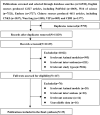What Is the Optimal Timing of Transplantation of Neural Stem Cells in Spinal Cord Injury? A Systematic Review and Network Meta-Analysis Based on Animal Studies
- PMID: 35371014
- PMCID: PMC8965614
- DOI: 10.3389/fimmu.2022.855309
What Is the Optimal Timing of Transplantation of Neural Stem Cells in Spinal Cord Injury? A Systematic Review and Network Meta-Analysis Based on Animal Studies
Abstract
Objective: The optimal transplantation timing of neural stem cells in spinal cord injury is fully explored in animal studies to reduce the risk of transformation to clinical practice and to provide valuable reference for future animal studies and clinical research.
Method: Seven electronic databases, namely, PubMed, Web of Science, Embase, Wanfang, Chinese Scientific Journal Database (CSJD-VIP), China Biomedical Literature Database (CBM), and China National Knowledge Infrastructure (CNKI), were searched. The studies were retrieved from inception to November 2021. Two researchers independently screened the literature, extracted data, and evaluated the methodological quality based on the inclusion criteria.
Results and discussion: Thirty-nine studies were incorporated into the final analyses. Based on the subgroup of animal models and transplantation dose, the results of network meta-analysis showed that the effect of transplantation in the subacute phase might be the best. However, the results of traditional meta-analysis were inconsistent. In the moderate-dose group of moderate spinal cord injury model and the low-dose group of severe spinal cord injury model, transplantation in the subacute phase did not significantly improve motor function. Given the lack of evidence for direct comparison between different transplantation phases, the indirectness of our network meta-analysis, and the low quality of evidence in current animal studies, our confidence in recommending cell transplantation in the subacute phase is limited. In the future, more high-quality, direct comparative studies are needed to explore this issue in depth.
Keywords: animal study; network meta-analysis; neural stem cells; spinal cord injury; systematic review; transplantation timing.
Copyright © 2022 Shang, Li, Chen, Wang, Wang, Zhang, Wang and Wanyan.
Conflict of interest statement
The authors declare that the research was conducted in the absence of any commercial or financial relationships that could be construed as a potential conflict of interest.
Figures










Similar articles
-
Mesenchymal Stem Cells for the Treatment of Spinal Cord Injury in Rat Models: A Systematic Review and Network Meta-Analysis.Cell Transplant. 2024 Jan-Dec;33:9636897241262992. doi: 10.1177/09636897241262992. Cell Transplant. 2024. PMID: 38910431 Free PMC article.
-
The optimal transplantation strategy of umbilical cord mesenchymal stem cells in spinal cord injury: a systematic review and network meta-analysis based on animal studies.Stem Cell Res Ther. 2022 Sep 2;13(1):441. doi: 10.1186/s13287-022-03103-8. Stem Cell Res Ther. 2022. PMID: 36056386 Free PMC article.
-
Systemic pharmacological treatments for chronic plaque psoriasis: a network meta-analysis.Cochrane Database Syst Rev. 2021 Apr 19;4(4):CD011535. doi: 10.1002/14651858.CD011535.pub4. Cochrane Database Syst Rev. 2021. Update in: Cochrane Database Syst Rev. 2022 May 23;5:CD011535. doi: 10.1002/14651858.CD011535.pub5. PMID: 33871055 Free PMC article. Updated.
-
Systemic pharmacological treatments for chronic plaque psoriasis: a network meta-analysis.Cochrane Database Syst Rev. 2017 Dec 22;12(12):CD011535. doi: 10.1002/14651858.CD011535.pub2. Cochrane Database Syst Rev. 2017. Update in: Cochrane Database Syst Rev. 2020 Jan 9;1:CD011535. doi: 10.1002/14651858.CD011535.pub3. PMID: 29271481 Free PMC article. Updated.
-
Direct-acting antivirals for chronic hepatitis C.Cochrane Database Syst Rev. 2017 Sep 18;9(9):CD012143. doi: 10.1002/14651858.CD012143.pub3. Cochrane Database Syst Rev. 2017. PMID: 28922704 Free PMC article.
Cited by
-
Molecular Mechanisms and Clinical Application of Multipotent Stem Cells for Spinal Cord Injury.Cells. 2022 Dec 28;12(1):120. doi: 10.3390/cells12010120. Cells. 2022. PMID: 36611914 Free PMC article. Review.
-
Stem cell therapy for locomotion recovery and neuropathic pain alleviation in spinal cord injury: an umbrella review and meta-analysis.Spinal Cord. 2025 Aug;63(8):393-409. doi: 10.1038/s41393-025-01104-x. Epub 2025 Jul 18. Spinal Cord. 2025. PMID: 40681655
-
Human dental pulp stem cells for spinal cord injury.Stem Cell Res Ther. 2025 Mar 7;16(1):123. doi: 10.1186/s13287-025-04244-2. Stem Cell Res Ther. 2025. PMID: 40055766 Free PMC article. Review.
-
Induced Neural Stem Cell Transplantation in Spinal Cord Injury: Present Status and Next Steps.Korean J Neurotrauma. 2024 Dec 26;20(4):234-245. doi: 10.13004/kjnt.2024.20.e45. eCollection 2024 Dec. Korean J Neurotrauma. 2024. PMID: 39803345 Free PMC article. Review.
-
Acute liver failure: A systematic review and network meta-analysis of optimal type of stem cells in animal models.World J Stem Cells. 2023 Jan 26;15(1):1-15. doi: 10.4252/wjsc.v15.i1.1. World J Stem Cells. 2023. PMID: 36713788 Free PMC article.
References
-
- GBD 2016 Traumatic Brain Injury and Spinal Cord Injury Collaborators . Global, Regional, and National Burden of Traumatic Brain Injury and Spinal Cord Injury, 1990-2016: A Systematic Analysis for the Global Burden of Disease Study 2016. Lancet Neurol (2019) 18:56–87. doi: 10.1016/S1474-4422(18)30415-0 - DOI - PMC - PubMed
Publication types
MeSH terms
LinkOut - more resources
Full Text Sources
Medical

